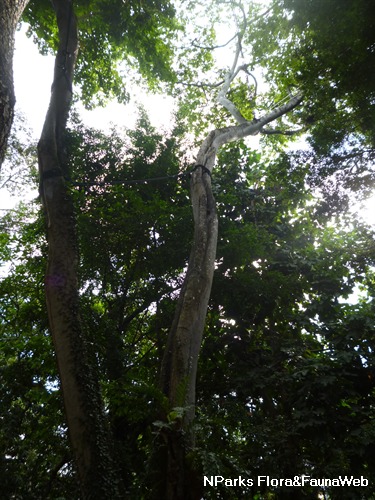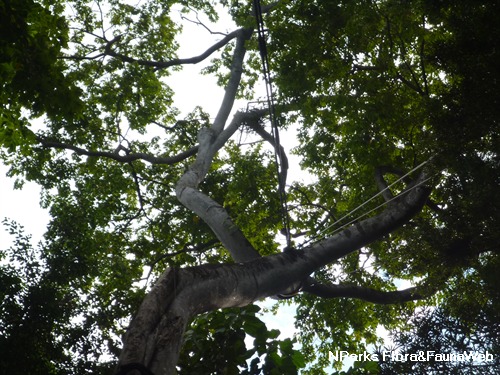
Back
Piscidia piscipula
| Family Name: | Fabaceae (Leguminosae) |
| Synonyms: | Erythrina piscipula, Piscidia erythrina, Piscidia inebrians Medik., Piscidia toxicaria Salisb., Robinia alata, Abrus communis S.F.Blake, Abrus piscipula (L.) Hitchc. |
| Common Name: | Jamaica Dogwood, Fish-poison Tree |
Name
Classifications and Characteristics
| Plant Division | Angiosperms (Flowering Seed Plants) (Dicotyledon) |
|---|---|
| Plant Growth Form | Tree |
| Lifespan (in Singapore) | Perennial |
| Mode of Nutrition | Autotrophic |
| Plant Shape | Irregular, Open |
Biogeography
| Native Distribution | Central America, Florida, West Indies, South America |
|---|---|
| Native Habitat | Terrestrial (Desert / Semi-Desert) |
| Preferred Climate Zone | Tropical, Desert / Arid |
Description and Ethnobotany
| Growth Form | It is a wide, dense and deciduous tree |
|---|---|
| Crown | Irregular |
| Foliage | Leaves compound, petiolate, alternate, odd pinnate; leaflets opposite, 5-9 leaflets, leaf margin entire |
| Flowers | Flowers zygomorphic; calyx 4 lobes, hairy; petals separate; petals clawed, pinkish; Stamens 9-10, united below; filaments glabrous; style terete. |
| Fruit | Fruit a legume, indehiscent, elongate, straight; seeds reniform, soft surface, olive-brown-black. |
| Etymology | The generic term arises from pisces- (latin name for fish) and caedo (latin name for kill) whereby the bark and roots are used to stun and catch fish. |
| Ethnobotanical Uses | Medicinal: The root barks are believed to have anti-inflammatory, sedative and antispasmodic effects. However, this plant is potentially toxic and should never be taken without a doctor's close supervision. Timber & Products: Its timber is used in boat and vehicle construction, posts and piling. Others: The bark and leaves are used as agents for anesthetizing fishes |
Landscaping Features
| Landscape Uses | Coastal |
|---|
Fauna, Pollination and Dispersal
| Fauna Pollination Dispersal Associated Fauna | Butterfly Host Plant |
|---|
Plant Care and Propagation
| Light Preference | Full Sun |
|---|---|
| Water Preference | Moderate Water |
| Plant Growth Rate | Moderate |
| Rootzone Tolerance | Moist Soils, Well-Drained Soils |
| Propagation Method | Seed |
Foliar
| Foliage Retention | Deciduous |
|---|---|
| Mature Foliage Colour(s) | Green |
| Foliar Type | Compound (Odd-Pinnate) |
| Foliar Arrangement Along Stem | Alternate |
| Foliar Attachment to Stem | Petiolate |
| Foliar Margin | Entire |
Non - Foliar and Storage
| Trunk Type (Non Palm) | Woody |
|---|
Floral (Angiosperm)
| Flower & Plant Sexuality | Bisexual Flowers |
| Flower Colour(s) | White, Pink |
|---|
Fruit, Seed and Spore
| Mature Fruit Colour(s) | Brown |
|---|---|
| Mature Fruit Texture(s) | Papery |
| Fruit Classification | Simple Fruit |
| Fruit Type |
Image Repository
Others
| Master ID | 31083 |
|---|---|
| Species ID | 5472 |
| Flora Disclaimer | The information in this website has been compiled from reliable sources, such as reference works on medicinal plants. It is not a substitute for medical advice or treatment and NParks does not purport to provide any medical advice. Readers should always consult his/her physician before using or consuming a plant for medicinal purposes. |

